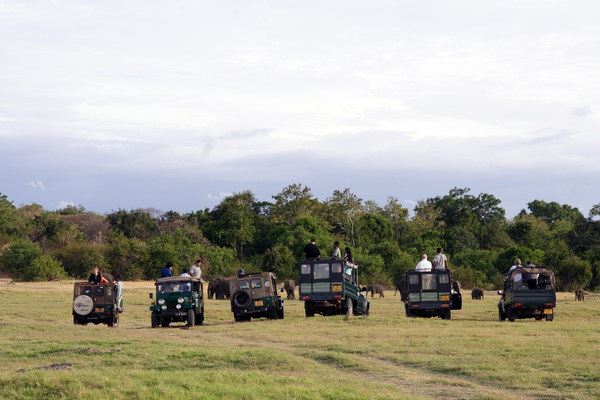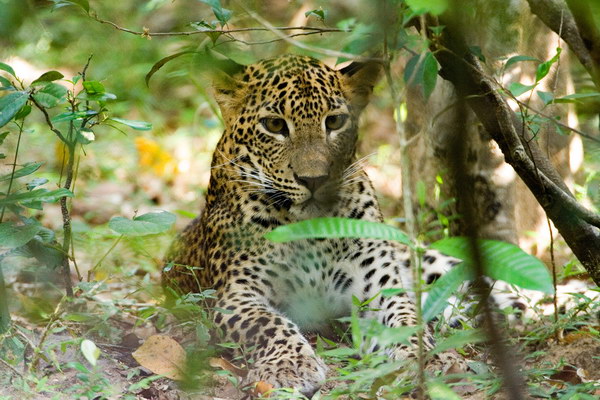
Sri Lanka, “the Pearl of Indian Ocean” is famous for its natural beauty and wild life. Sri Lanka is home to world famous wild life parks and forests. There are about 21 national parks administered by the Department of Wild Life Conservation of Sri Lanka. The list is as follows;
Yala, Wilpattu , Gal Oya, Kumana, Udawalawe, Lahugala Kitulana, Maduru Oya, Wasgamuwa, Flood Plains, Somawathiya, Horton Plains, Bundala, Lunugamwehera, Minneriya, Kaudulla, Hikkaduwa, Pigeon Island, Horagolla National Park, Galway’s, Angammadilla and Ussangoda.
Although there are 21 National Parks gazetted by the Government of Sri Lanka, very few are popular amongst tourists. Amongst these are Yala, Wilpattu, Kumana, Udawalawe, Wasgamuwa, Somawathiya, Horton Plains, Bundala, Minneriya and Hikkaduwa national parks.

Wilpattu, Somawathiya, Kaudulla, Maduru Oya, are situated in and around the North Western, North Central and Eastern Provinces, which were highly affected by the terrorism for past thirty years. Therefore, due to security concerns, these national parks were closed for public for the past 10 to 15 years. Now, the peace has regained and these national parks are again open to the public. But, the facilities for tourists are limited because the areas were devastated after nearly three decades of war. The Government of Sri Lanka and lot of other private organizations are involved in the development of these areas and hence, the tourism industry is expected to thrive in the time to come.
Yala, Wilpattu, Gal Oya, Kumana, Udawalawe, Lahugala Kitulana, Maduru Oya, Wasgamuwa, Flood Plains, Somawathiya, Bundala, Lunugamwehera, Minneriya, Kaudulla, Angammadilla and Ussangoda national parks are situated in the dry zone. Horton Plains, Horagolla and Galway’s Land national parks are situated in the wet zone. Hikkaduwa and Pigeon Island national parks are the only marine national parks in Sri Lanka.
Although, Wilpattu National Park is the largest national park in Sri Lanka, the Yala National Park is the most visited national park amongst tourists being the second largest national park. The unique feature of Wilpattu is the existence of Willus (Natural Lakes). Nearly six willus (lakes) are found spread in the Wilpattu National Park and it is among the top national parks world renowned for its leopard (Panthera pardus) population.
The national parks like Kumana, Bundala, Lahugala Kitulana and Flood Plains are mainly wet lands consisting of lagoons and small tanks, which make ideal environment for the local and migratory avifauna, specially waterfowl and wading birds. These national parks are ideal for the tourists, who prefer bird watching.
Udawalawe, Wasgamuwa, Somawathiya, Minneriya, Maduru Oya, Kaudulla and Lunugamwehera national parks are particularly famous for its elephant (Elephas maximus maximus) population, and during the dry season, tourists gather to watch elephants coming to tanks and small lakes to bathe and quench their thirst. This is a very beautiful sight and attracts both local and foreign tourists to these national parks. Minneriya, Wasgamuwa and Udawalawe are very famous for watching elephants.
Pigeon Island and Hikkaduwa are the two marine national parks of Sri Lanka. Pigeon Island National Park contains some of the best coral reefs in Sri Lanka. Hikkaduwa contains a fringing coral reef which has a very high degree of biodiversity.
Horton Plains National Park is situated in the central highlands and it is covered by montane grass lands and cloud forests. Horton plains National Park is rich in biodiversity and it was declared as a world heritage site by UNESCO in July, 2010.
Horagolla National Park is one of the latest national parks declared by the government and it is the only urban park in the Western Province.
Ussangoda is the newest and the 21st national park of Sri Lanka. The area’s biological, archeological and geological values were considered to declare it as a national park
Apart from these 21 national parks, there are other protected areas, which are important ecologically and due to their rich biodiversity. Amongst those protected areas, Sinharaja rain forest ranks the top. Sinharaja Forest Reserve has been declared as a world heritage site by UNESCO. It is the last patch of low land evergreen rain forest still remaining more or intact or undisturbed in Sri Lanka. Also, the UNESCO has declared Horton Plains National Park, Knuckles Conservation Forest and Peak Wilderness Protected Area as world heritage sites in 2010.
It’s amazing how such a small island like Sri Lanka has so many national parks, which has huge climatic differences and which are rich in biodiversity. It’s not only the duty of the government, but the duty of all of us as individuals to protect these natural resources and conserve them to our future generation.
Sri Lankan Elephant (Elephas maximus maximus)
The Sri Lankan elephant is a subspecies of the Asian elephant, which is confined to the island of Sri Lanka. It is estimated that about 2500-3000 elephants found in the wild and about 500 in captivity.
The Sri Lankan elephant differs from the African elephant mainly by having smaller ears. The profile of the back of the Sri Lankan elephant is convex (males) and straight and level (females), while the African is concave. Another much less obvious difference can be seen in the trunk. The Sri Lankan elephant bares two finger-like protrusions while the African has one. Generally, the Sri Lankan elephant has more hair in its body than the African, which is conspicuous in newborns and juveniles. Mature Sri Lankan elephants display heavy pinkish pigmentation in around the ears, face and trunk. Only Sri Lankan male elephants bare tusks.

The elephant has a very inefficient digestive system. Around 45% of the food intake is removed as undigested. Therefore, most of the elephant’s life is spent on eating.
All elephant subspecies has one of the longest gestation periods in the animal kingdom, of 18-20 months. Usually, only one calf is born.
The Sri Lankan elephant can be seen in most of the national parks of Sri Lanka such as Yala, Wilpattu, Udawalawe, Bundala, Minneriya, Wasgamuwa, Kaudulla, Somawathiya and Lunugamwehera.
There are various efforts taken to protect and conserve the highly endangered Sri Lankan elephant. The Pinnawala Elephant Orphanage and Eth Athuru Sevana are results of those efforts.
In Sri Lanka, the elephant is considered as a religious icon from the ancient era and it was used to carry the casket of Tooth Relic during the Kandy Dalada Perahera. Also, the elephant was used in wars and other activities which need lot of man power such as carrying goods and logs.
Sri Lankan Leopard (Panthera Pardus )

The Sri Lankan leopard is one of the currently known eight subspecies of leopards. Leopards have lithe bodies supported on relatively stocky legs and broad paws. The coat of the leopard is a tawny or rusty yellow, marked with dark spots and rosettes. Very less is known about the Sri Lankan leopard and no detailed scientific study has been done yet. The leopard has been observed in a variety of habitats including dry evergreen monsoon forests, arid scrub jungles, low and upper montane (highland) forests, rainforests, and wet zone intermediate forests.
The diet of leopard can include small mammals, birds, reptiles as well as larger animals. The spotted deer makes up the major part of the diet of leopard in the Yala National Park. The Sri Lankan leopard is capable of tackling even bigger prey such as fully grown buffalos.
Leopards are primarily arboreal and nocturnal. Except the femals and cubs, the leopard is generally a solitary animal.
The litter is normally two cubs and breeding is thought to take place in the dry season.
The Sri Lankan leopard is threatened due to poaching, habitat loss and persecution. Proper conservation methods are needed in order to protect these endangered creatures.
According to a recent study, it has revealed that the Yala National Park has one of the highest recorded leopard densities in the world. Wilpattu National Park is also a popular place to observe leopards.
Sri Lankan Sloth Bear (Melursus ursinus inornatus)

The subspecies of sloth bear M.u.inornatus is endemic to Sri Lanka. It is distributed in the lowland forests of the northern, north central, eastern and southeastern regions, and absent in the hill country and the southwest. It is highly threatened and can be named as one of the first animals to disappear from Sri Lanka.
Sloth bears are typically opportunistic omnivores, eating a large variety of plant and animal foods and switching their diet depending on the availability and abundance of various food items.Its selective feeding habits seem to demand a large extent of healthy forest. The sloth bear’s food is apparently an endless diversity of fruits, flowers, seed pods, yams, grubs, insects, honey and insect larvae. It is therefore the disappearance of suitable habitat that poses the greatest threat to the sloth bear’s survival in Sri Lanka.
The sloth bear has a comparatively poor sight and hearing, but this is compensated by the highly developed sense of smell.
Adult sloth bears are usually solitary, except during the breeding season, but family units of a mother and small to almost-mature offspring are common. There is no clear indication that sloth bears are territorial. Sloth bears can be rather noisy at times; their vocal repertoire includes roars, howls, screams, barks and squeals, associated with mating or fights with other bears.
The reproductive rate of sloth bear’s is among the lowest in mammals. Gestation may last from 4-7 months and the females are most often seen with one cub, but a female with two cubs is not uncommon.